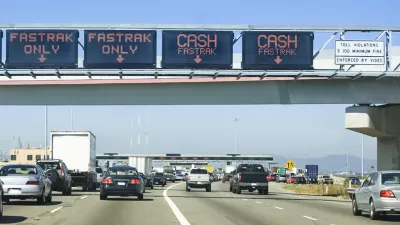"What program would you cut to continue the same level of transportation spending without raising the gas tax, e.g. cancer treatment programs, Head Start?," asks Streetsblog USA's Tanya Snyder after reading Sen. Bob Corker's (R-Tenn.) recommendation.
Sen. Bob Corker, who sits on the powerful Banking, Housing, and Urban Affairs, one of three committees responsible for measures to be included in the MAP-21 Reauthorization Act, sent a letter [PDF] on May 14 to the heads of the other two Senate committees: Environment and Public Works Committee and the Finance Committee, which at first glance might seem that he advocated increasing the federal gas tax to provide the necessary funds to fill the Highway Trust Fund shortfall, the difference between spending and gas tax receipts.
In the last few years, Congress has allowed the [Highway Trust Fund] to become one of the largest budget gimmicks in the federal government. Spending from the HTF has far outpaced [gas tax] revenues in recent years, taking us away from our traditional user fee, pay-as-you-go transportation financing model. Instead of enacting a permanent solution to this problem, we have transferred more than $50 billion of general fund money [$54 billion according to this NPR report] to maintain funding levels.
Corker's press release, which includes his letter, is even more direct, calling for "reestablishing (the) self-sustaining highway program" in the title.
He gets it! If you stopped reading there, you'd be very pleased that a senator is saying what we all know, that the "permanent solution", at least for this go-around of the transportation reauthorization act, is to bring the trust fund into solvency sticking to the "traditional user fee, pay-as-you-go transportation financing model."
Snyder takes it from here:
Then he lays out two options for solving the problem: “(1) increasing dedicated HTF user fees to match spending levels, or (2) reducing HTF spending to match dedicated HTF revenues.” He quickly dispenses with the first: “It is my belief that reducing spending to current HTF revenue levels would be damaging to our nation’s infrastructure, competitiveness, and economic growth.” Good show, Senator! So that leaves us with increasing the user fee, correct?
Not so fast. “Another alternative that would at least make Congress accountable for the increased spending is to offset HTF spending that exceeds revenues by reducing other government spending by an equal amount,” he wrote.
The "third strategy", off-setting the general fund transfers [see his press release], does nothing to restore the user-pay system that the Highway Trust Fund is based on. Snyder suggests that the Corker strategy would result in "lawmakers end(ing) up cutting cancer treatment programs and Head Start and meals on wheels. All to make sure drivers don’t have to pay their own way."
Seems like another gimmick to me.
FULL STORY: Sen. Bob Corker Sets Up for Gas Tax Increase, Yanks the Football

Depopulation Patterns Get Weird
A recent ranking of “declining” cities heavily features some of the most expensive cities in the country — including New York City and a half-dozen in the San Francisco Bay Area.

California Exodus: Population Drops Below 39 Million
Never mind the 40 million that demographers predicted the Golden State would reach by 2018. The state's population dipped below 39 million to 38.965 million last July, according to Census data released in March, the lowest since 2015.

Chicago to Turn High-Rise Offices into Housing
Four commercial buildings in the Chicago Loop have been approved for redevelopment into housing in a bid to revitalize the city’s downtown post-pandemic.

EV Infrastructure Booming in Suburbs, Cities Lag Behind
A lack of access to charging infrastructure is holding back EV adoption in many US cities.

Seattle Road Safety Advocates Say Transportation Levy Perpetuates Car-Centric Status Quo
Critics of a proposed $1.3 billion transportation levy say the package isn’t enough to keep up with inflation and rising costs and fails to support a shift away from car-oriented infrastructure.

Appeals Court: California Emissions Standards Upheld
The U.S. Environmental Protection Agency and the California Air Resources Board, the nation's two most powerful environmental regulatory agencies, won an important round in federal court last week. But the emissions standards battle may not be over.
Barrett Planning Group LLC
City of Cleburne
KTUA Planning and Landscape Architecture
HUD's Office of Policy Development and Research
Mpact Transit + Community
HUD's Office of Policy Development and Research
City of Universal City TX
ULI Northwest Arkansas
City of Laramie, Wyoming
Urban Design for Planners 1: Software Tools
This six-course series explores essential urban design concepts using open source software and equips planners with the tools they need to participate fully in the urban design process.
Planning for Universal Design
Learn the tools for implementing Universal Design in planning regulations.




















